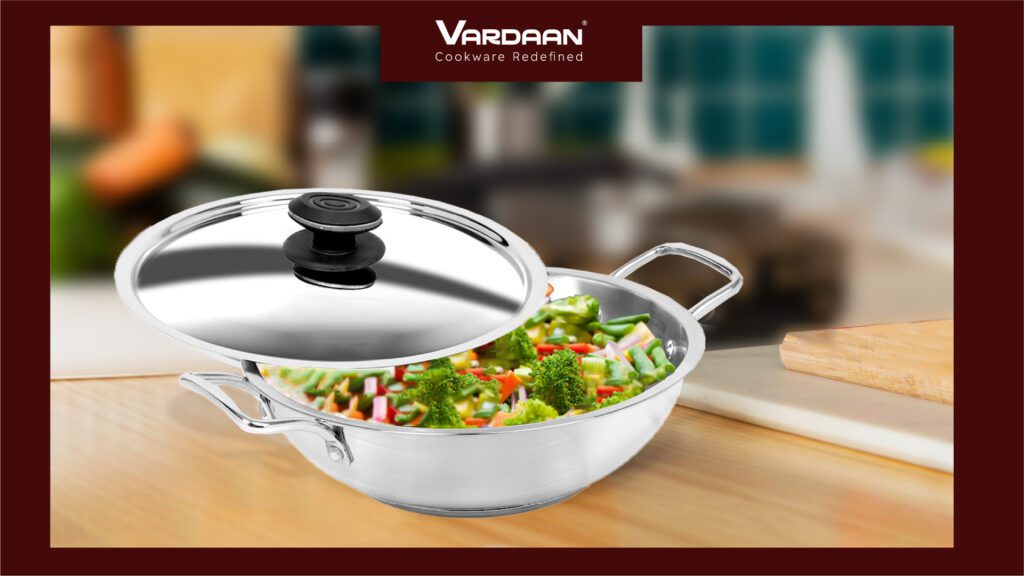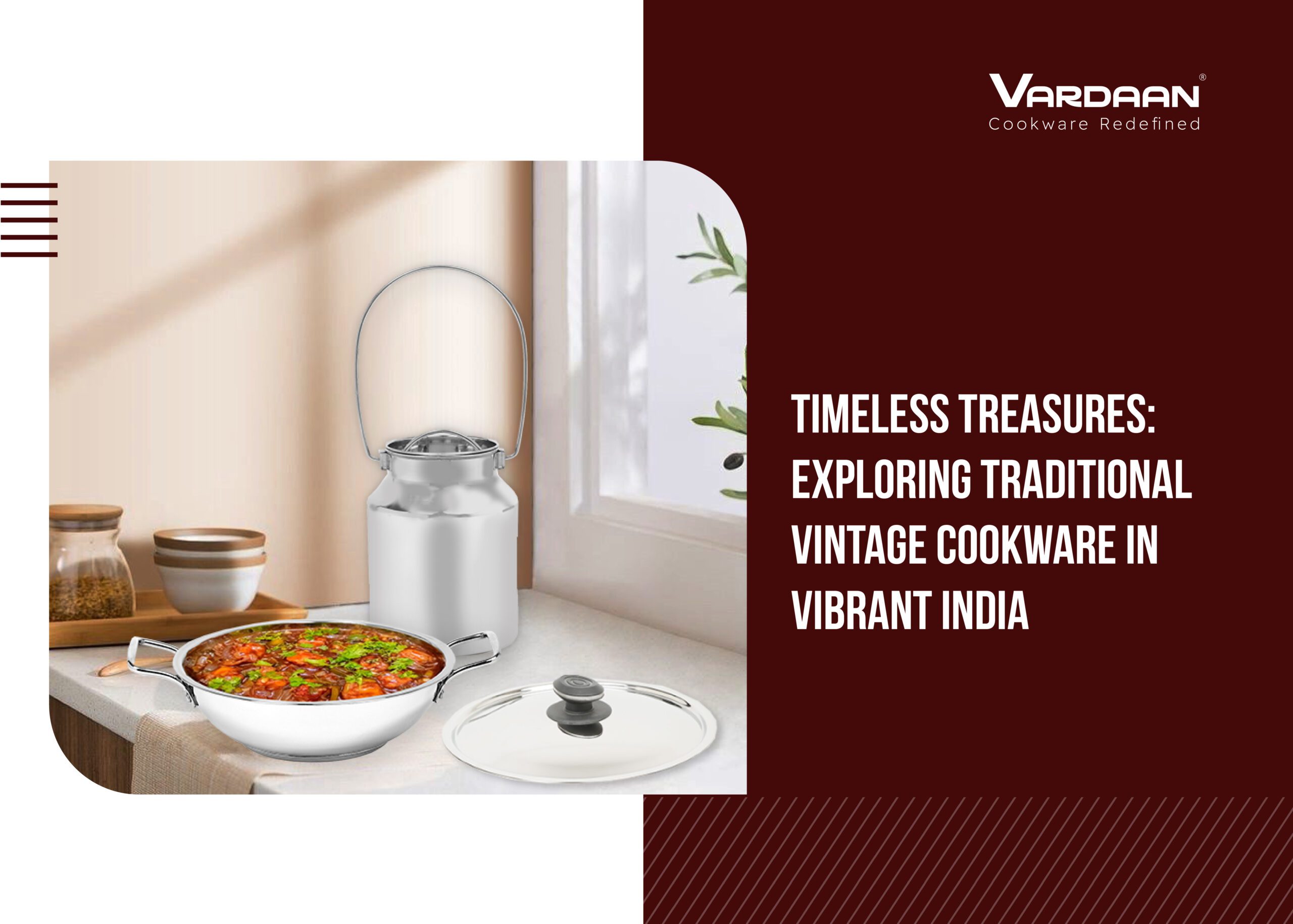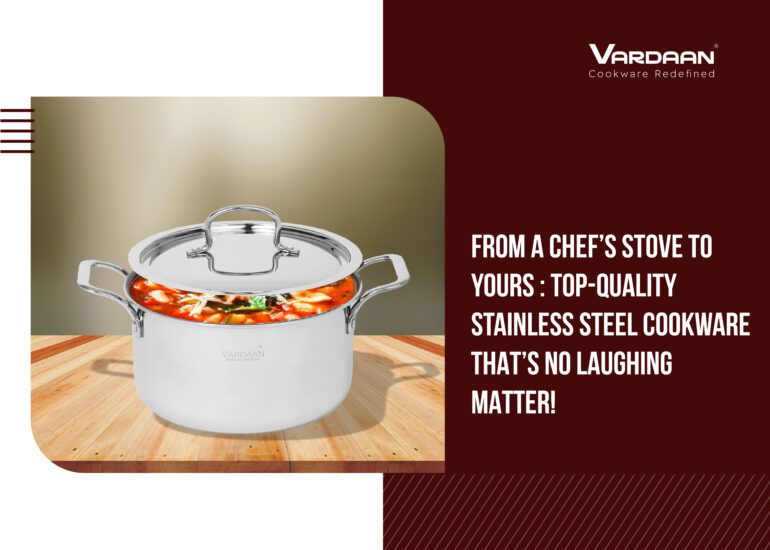Traditional and vintage cookware encapsulates the rich heritage of culinary tools that have stood the test of time. These timeless pieces bear witness to generations of cooking, holding within them a unique blend of craftsmanship, culture, and culinary wisdom passed down through the ages.
Cultural Significance of Cookware in India:
- Symbolism: Cookware holds a revered place in Indian households, symbolizing nourishment, tradition, and family bonds.
- Regional Diversity: Each state boasts distinct cuisines, inspiring a vast array of cookware designs tailored to specific dishes.
- Stainless Steel Kadhai: The iconic stainless steel kadhai, often passed down through generations, reflects both functionality and cultural heritage.
- Cooking Rituals: Elaborate cooking rituals, from the sizzle of spices in a stainless steel kadhai to the art of kneading dough, are integral to India’s culinary rituals.
Diverse Indian Cuisine and Cooking Vessels:
- Bread Varieties: Tandoors and griddles are used for flatbreads like naan and roti, showcasing India’s regional bread diversity.
- Spice Infusion: Copper utensils facilitate the perfect blend of spices, essential to curries and aromatic Indian delicacies.
- Earthen Pots: Clay pots (matka) enhance slow-cooked flavors, enriching biryanis and stews, embodying India’s earthy culinary traditions.
- Stainless Steel Kadhai with Lid: A staple like the stainless steel kadhai with lid encompasses a multitude of regional flavors, embodying unity in diversity.
Traditional Cookware
Iconic Indian cookware, from the rustic clay pots (matka) to the gleaming brass utensils and sturdy iron kadai, forms the heart of traditional kitchens. Beyond their utilitarian role, these vessels bring a touch of heritage to culinary practices.
Using such traditional cookware isn’t just nostalgic; it enhances flavors and offers health benefits. Clay pots infuse dishes with an earthy aroma, brass utensils aid digestion, and iron kadai impart essential nutrients to food, enriching the dining experience.
Families treasure tales of sumptuous curries simmering in heirloom brass utensils, or the humble iron kadai turning out crispy delights. The matka, besides cooling water naturally, adds a hint of tradition to festive drinks. These stories speak to the emotional connection these cookware pieces foster in Indian households, making meals not just about taste, but also about cherished memories.
Vintage Cookware
Delving into vintage cookware reveals cherished ancestral heirlooms, embodying the culinary journeys of bygone eras. These utensils, lovingly passed down through generations, bridge the gap between the past and present.
Vintage cookware stands as a testament to exquisite craftsmanship, with intricate designs reflecting the aesthetics of their times. Brass utensils boast ornate engravings, while copper vessels showcase captivating patinas—each piece an artisanal masterpiece.
Cooking with vintage utensils evokes a sense of nostalgia, transporting chefs to a simpler time. The familiar clank of iron cookware and the gentle gleam of aged metal evoke memories of grandparents’ kitchens, infusing meals with an extra dash of warmth and sentiment. These culinary time capsules link generations and stories, turning cooking into a heartwarming journey through time.
Cultural Significance
Intricately woven into the cultural fabric, cookware embodies rituals and traditions. Brass utensils, gleaming during festivals, symbolize auspiciousness and prosperity. Regional cuisines and specialties find companionship in specific vessels, like the tandoor for North Indian bread or the idli steamer down south. Beyond sustenance, cookware nurtures familial bonds, with shared cooking experiences becoming a cherished heritage. Passing down recipes and techniques through these vessels cements cultural practices, ensuring the flame of tradition burns bright. Cookware thus becomes more than tools; they are vessels of stories, connecting the present with the past, and the family with its roots.
Here’s a comparative chart detailing the benefits of using traditional and vintage cookware, along with potential challenges:

| Benefits | Traditional Cookware | Vintage Cookware |
| Even Heat Distribution | Clay pots offer consistent cooking. | Brass utensils evenly conduct heat. |
| Reduced Environmental Impact | Clay and metal are natural materials. | Vintage pieces reduce plastic usage. |
| Richer Flavors | Clay enhances flavors over time. | Brass and copper infuse unique tastes. |
| Healthier Cooking | Cast iron imparts trace minerals. | Copper has antimicrobial properties. |
| Cultural Connections | Connects to heritage and traditions. | Preserves family stories and rituals. |
| Challenges | Traditional Cookware | Vintage Cookware |
| Maintenance | Clay pots need careful handling. | Brass requires periodic polishing. |
| Availability | Some pieces may be region-specific. | Finding authentic pieces can be hard. |
| Modern Adaptation | Requires adjustment to cooking methods. | Learning to cook with unique designs. |
| Initial Investment | Quality pieces may have higher costs. | Antique pieces might be pricier. |
| Limited Convenience | May lack modern features like non-stick. | Some pieces may not fit modern needs. |
Balancing the benefits and challenges of traditional and vintage cookware, such as the timeless stainless steel kadhai with lid, can offer a rewarding culinary experience while contributing to a greener environment and a deeper connection to cultural roots.
Exploring Cookware Treasures in Local Markets:
Navigate vibrant bazaars in India’s heart, like Delhi’s Chandni Chowk or Mumbai’s Crawford Market, where traditional and vintage cookware awaits discovery. Cities renowned for their unique offerings include Jaipur for brassware and Kolkata for copper. To identify authentic pieces, inspect craftsmanship, look for patina on vintage metalware, and study regional designs. Engage vendors, learn local names for items, and haggle respectfully to secure prized pieces. In these bustling markets, each purchase not only fills your kitchen but also connects you to the living heritage of India’s culinary traditions.
Culinary Harmony of Traditional Cookware:
Traditional Indian cookware is tailored to perfection, elevating beloved dishes. A stainless steel kadhai with a lid, for instance, lends itself seamlessly to biryanis, allowing slow cooking for aromatic blends. Tandoori delicacies thrive in clay ovens, while sweets like kheer simmer to creamy perfection in brass vessels. Classic recipes such as Chicken Biryani, cooked in a stainless steel kadhai, or Naan, baked in a tandoor, exemplify this harmony. Nuances of cooking materials, whether copper, iron, or clay, influence flavors, infusing distinct character into every creation—a culinary journey steeped in heritage.
Reviving Traditional Cookware:
In a bid to preserve culinary legacies, initiatives like “Cookware Revival Workshops” and organizations such as “Indian Culinary Heritage Foundation” champion traditional cookware. They conduct workshops, demonstrations, and awareness campaigns, igniting a resurgence of time-honored techniques. Embracing vintage utensils not only rejuvenates heritage but also aligns with sustainability. Durable materials like stainless steel kadhai with lid echo eco-friendliness by reducing disposables. As modern kitchens embrace tradition, they foster a sustainable narrative, where cookware becomes a conduit not just for exquisite flavors, but also for a greener, more mindful culinary future.
Here are some sources and references for authentic traditional cookware and further reading on Indian cookware heritage:
- Vardaan Cookware: Explore a range of authentic Indian cookware, including stainless steel kadhai with lid, saucepans, frying pans, stainless steel barnis and more.
Markets for Exploring and Purchasing Traditional Cookware:
- Chandni Chowk Market, Delhi: Known for its vibrant lanes, it offers an array of traditional cookware.
- Crawford Market, Mumbai: A hub for kitchen essentials and vintage cookware.
- Johari Bazaar, Jaipur: Famous for brassware and utensils.
Further Reading on Indian Cookware Heritage:
- The Legacy of Indian Cookware: An insightful article on the historical significance of Indian cookware.
- Traditional Indian Cookware: A Nostalgic Journey: Explores the nutritional and cultural aspects of traditional cookware.
- Indian Cookware: An Exploration of Materials and Techniques: A comprehensive guide to the materials and techniques used in Indian cookware.
Finally, Embark on a Culinary Odyssey
Step into the enchanting realm of traditional and vintage cookware in India, where each piece weaves a tale of enduring beauty and cultural heritage. From the timeless charm of brass utensils to the earthy allure of clay pots, these treasures paint a vivid canvas of Indian cuisine’s rich history. As we journey through the shimmering tapestry of flavors, textures, and aromas, let’s celebrate the culinary magic that these pieces bring. Discover more at Vardaan Cookware, where you can own a piece of this culinary legacy and savor the essence of Indian tradition in your kitchen.




